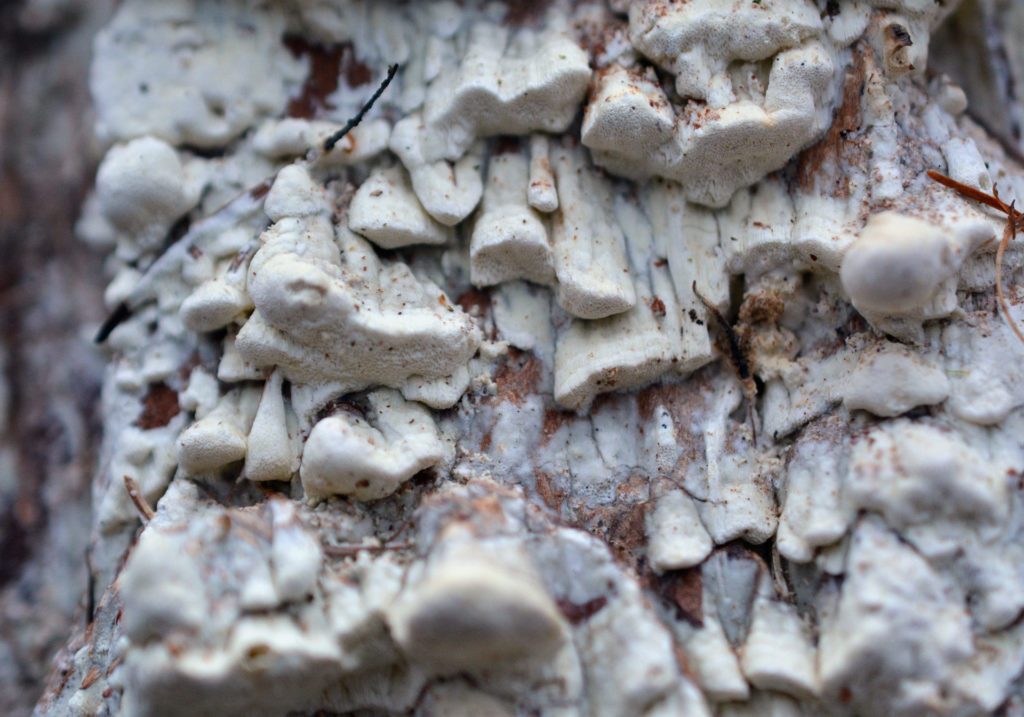Classification
Kingdom Fungi
Phylum Basidiomycota
Class Basidiomycetes
Order Polyporales
Family Meripilaceae
Genus Antrodia
Synonyms
Amyloporia xantha (Fr.) Bondartsev & Singer ex Bondartsev
Amyloporia xantha f. pachymeres J. Erikss.
Antrodia xantha f. pachymeres (Fr.) J. Erikss.
Chaetoporellus greschikii (Bres.) Bondartsev & Singer ex Bondartsev
Daedalea xantha (Fr.) A. Roy & A.B. De
Physisporus xanthus (Fr.) P. Karst.
Polyporus flavus P. Karst.
Polyporus selectus P. Karst., Not. Sällsk. Fauna et Fl. Fenn. Förh.
Polyporus sulphurellus Peck
Polyporus xanthus Fr.
Poria greschikii Bres.
Poria selecta (P. Karst.) Rodway & Cleland
Poria sulphurella (Peck) Sacc.
Poria xantha (Fr.) Cooke
Description
Spreading, creamy-yellow, partly encrusting, partly hoof-like, the pore-bearing surface exposed as vertical ‘lacerations’ between individual brackets, annual; in overlapping tiers on vertical surfaces of dead conifer stumps and other timber.
Dimensions: variable diameter overall, individual brackets 1-3 cm diameter x 0.5-1 cm thick.
Fruiting body: upper surface pale cream to pale straw yellow, with slightly iridescent appearance, irregular, lumpy hoof-shaped, margin thinning, undulating.
Flesh: whitish, soft when damp, chalky when dry.
Pores: concolorous, small, sub-circular or angular, lacerate, exposed vertically, 5-7 per mm. Tubes white, 3-5 mm deep.
Spores: hyaline, smooth, allantoid, non-amyloid, thin-walled, 4-5 x 1-1.5 µm.
Basidia: clavate, 10-15 × 4-5 µm, 4-spored. Cystidia absent.
Cystidioles: present, apically pointed, 10-14 × 3-4 µm, thin-walled.
Odor: sweetish.
Taste: bitter.
(Description modified from Wu, 1996, and Jordan, 2004, p. 98).
Medicinal properties
Antiangiogenic (antitumor) effects
It is known that during tumor growth, increased reactive oxygen species activate tumor-infiltrating leukocytes to induce an angiogenic response. Hence, the delay of new blood vessel growth using angiogenesis inhibitors is an important aspect of cancer chemotherapy. In one study, polysaccharides extracted from Antrodia xantha were investigated for its effects on vascular endothelial growth factor (VEGF)-induced tube formation in endothelial cells (ECs). Chemical analysis revealed that the polysaccharides were composed of the neutral sugars myo-inositol, sorbitol, fucose, galactosamine, glucosamine, galactose, glucose, and mannose. However, the monosaccharides fucose, glucose and mannose from A. xantha had the greatest inhibitory effects on endothelial tube formation. The results showed that polysaccharides from A. xantha show greater antiangiogenesis than those from commercialized A. murrill (Brazilian mushroom) and A. cinnamomea (Chen et al., 2005).

My name is Austin Collins.
I've dedicated my life to Mushrooms.
I believe Mushrooms are the best kept secret when it comes to health and well being.
For that reason, I would like to share a company with you that in my opinion makes the best mushroom products on the market.
The company is called Noomadic Herbals, my favorite supplement they make is called "Mushroom Total".
I take their products every day and they have helped me think better and have more energy. Give them a try.
-Austin
Chen SC, Lu MK, Cheng JJ, Wang DL.
Antiangiogenic activities of polysaccharides isolated from medicinal fungi.
FEMS Microbiology Letters. 2005 249(2):247-54.
Jordan M. (2004).
The Encyclopedia of Fungi of Britain and Europe.
Frances Lincoln Ltd. 384 pp.
Google preview available here.
Wu S-H.
Resupinate polypores (Basidiomycotina) newly recorded from Taiwan.
Bot Bull Acad Sin. 1996 37:151-8.
Text available here.



